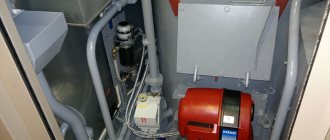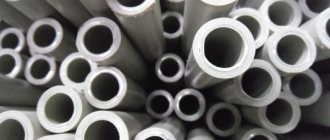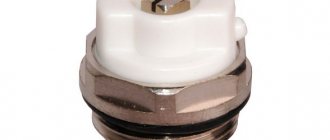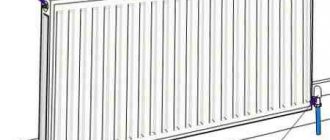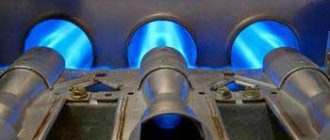Principle of operation
Some people mistakenly believe that steam and water heating are the same thing.
But the main difference is in the coolant. The first contains steam, and the second contains water. It is not the furnace or boiler room that heats everything, but only the boiler. The main boiler heats and evaporates the poured water. Wet steam streams rush through the wiring, releasing thermal energy.
Therefore, not every boiler can perform such functions.
Visual operating principle
The steam formed as a result of heating has a high thermal potential, which is released at the moment of condensation. That is, as boiling products move through the pipeline, they gradually cool down. The water condenses, returning to its original state.
The moisture then moves naturally or under the influence of a pump back to the boiler room, where the heating cycle begins again.
Energy use
Hot water radiator
Water heaters are considered more energy efficient than steam radiators. This is because water heaters move water through the system using a pump, which allows the water to move at a predictable rate.
Steam radiator
Steam radiators are considered less energy efficient than water heaters because they take longer to boil water and release steam.
Best for energy use: hot water radiator. Hot water radiators deliver hot water faster and more predictably than steam radiators. However, both water and steam radiators are considered energy efficient because they can be zoned; Radiators can be switched on and off in separate rooms.
What are the disadvantages
Steam heating is not suitable for everyone due to existing imperfections.
The hot steam heats up the batteries so much that you can get burned from touching them.
When steam and water are mixed, rust forms inside the pipes, gradually clogging the space, increasing the likelihood of sudden depressurization.
If the joints are broken, a steam stream escapes, which can cause severe burns.
If the homeowner is allergic to dust, it is not recommended to install such heating, due to the acceleration of air circulation.
The air space inside the room dries out greatly, which can lead to frequent colds and a cough that does not go away for a long time.
The choice of pipes and building materials for finishing is very limited, since not every type of raw material can withstand a high degree of heat.
A simple connection diagram eliminates temperature control. Separate switching on or off of parts of the circuit is allowed.
The problem may be the noisy operation of the boiler.
DIY steam heating
The installation of steam heating consists of two stages - design and installation itself.
Stage 1. System design
System design
We remind you once again about the peculiarities of using steam as a coolant - the high temperature of the pipeline and radiators, as well as an increased accident rate. When all the pros and cons are weighed, you can begin work. First, a draft of the future system is created.
Boiler
Wood boiler
First, the required power of the heat generator is determined. In this case, the area of the house is taken into account - if it does not exceed 200 m², then a device with a power of 25 kW is sufficient, but if it fluctuates between 200 m² and 300 m², then a minimum of 30 kW will be required. Based on this information, a boiler is selected. The following factors should be considered when purchasing:
- the type of fuel that will be used;
- possibility of heating water for domestic needs.
Heating scheme
Two-wire system with top wiring
Single-wire system with bottom wiring
Diagram of an open heating system
The scheme also needs to be decided in advance. The choice of one option or another depends on:
- boiler location;
- area of the heated room;
- conditions for installation of heating devices;
- the required number of these devices.
In short, this is a rather difficult choice, in which the video below will help.
Pipes
For steam heating, the use of conventional plumbing pipes is unacceptable due to the high temperature of the entire system
For this reason, great attention should be paid to the choice of pipes, even if it is small.
- Copper pipes are characterized by excellent thermal conductivity and high cost. Installation is carried out by soldering.
Copper pipes
- The advantage of steel pipes is their resistance to aggressive environments and mechanical stress, the disadvantage is their susceptibility to corrosion. A welding machine is required to install them.
Steel pipes
- Galvanized products combine the positive qualities of the previous ones - they do not rust and are relatively inexpensive. The pipes are joined using a threaded connection.
Galvanized products
In order to facilitate installation work, at the design stage it is necessary to determine:
- location of radiators;
- pipeline length;
- installation locations for distributors, main line branches, adapters, etc.
Price issue
After drawing up the project, future costs are determined. It is difficult to say how much the equipment of such a system will cost, without reference to heating devices, scope of work and specific conditions. Let us only note that, according to experts, steam heating will in any case be cheaper than conventional water heating.
Stage 2. Installation work
Step 1. First, based on the sketch, an exact wiring diagram is drawn.
Heating wiring diagram
Step 2. Next, radiators are installed. It is recommended to place them under the windows - this will not only heat the glass, but also prevent fogging and, as a result, a shift in the “dew point”.
Connecting a multi-section radiator
Installing a heating radiator
Installing a heating radiator
Radiators are installed next
Step 3. The expansion tank is attached. It must be connected to the pipeline leading from the heat generator to the radiators. Another important point: the tank must be installed at the highest point of the heating system.
Fastening the expansion tank
Fastening the expansion tank
It can be closed or open, with or without overflow.
Step 4. Pipelines are installed. This happens as follows: the pipe is brought to the radiator, cut if necessary, after which the leads and inputs are connected. Then the pipe is connected in the same way from the first radiator to the second, then from the second to the third, etc.
Step 5. The circuit is closed, that is, it is brought to the beginning - the heat generator
It is important that the boiler is equipped with a filter and (if necessary) a circulation pump
Vortex heat generator
Step 6. Next you need to install the boiler itself. Quite often, country houses are adjacent to car garages. The heating device can be installed in one of these garages.
Heating boiler installation
In this case, installing a heat generator is no different from a similar procedure in a residential area. In this case, the fill/drain unit can be installed on any section of the highway. This unit is necessary to drain the coolant at the end of the heating season or before repairing the system.
Step 7. All heating devices are tested. If they are new, then it is advisable to invite a specialist for a test run.
45 degree cutting
But, if you still need to cut a round pipe made of steel or various types of plastics, then for this you will need a pattern for cutting pipes at an angle, the shape of which is calculated manually or by machine. The task is greatly simplified if it is necessary to cut a square metal profile at an angle of forty-five degrees.
For quick cutting, you can use a regular sheet of paper folded diagonally to mark the surface for future cutting. When using folded paper, proceed as follows:
- carry out on a straight surface of the profile in the place where the cut is made, strictly perpendicular to the line;
- apply a sheet of paper folded diagonally to the side surface with the sharp end to the line so that the upper edge of the paper triangle is flush with the top side of the metal profile.
Rice. 2 Homemade template for cutting pipes at 45 degrees
draw a line with a pencil along the side of the sheet at an angle of 45 degrees, after which the paper corner is applied to the other side and traced with a pencil (it is better to use a thin marker).
For sawing, you can use a grinder with a metal disc, first drawing a thin line along the marking, and then gradually deepening it until the edges are completely separated.
Making a template for cutting metal profiles
If you need to cut a large number of pipes, you can make a template from a metal profile of a larger diameter using a paper sheet using the above method. The angle of inclination is checked with a protractor or a construction square - in this case, the two edges of the cut parts of the template are connected.
When working, a template is placed on the part to be cut in the right place and pressed tightly, the markings are applied with a sharply sharpened scriber while tracing the template outline. The part is cut in several passes with a gradual deepening of the groove.
Rice. 3 Cutting a metal profile using a miter box
DIY miter box for cutting pipes
Using a template is not very convenient - you have to make a cut along the line, holding the grinder in weight, which leads to large errors. If you have a welding machine, you can make a simple miter box - guides for the grinder disk, preventing it from moving to the side.
To do this, use a previously made template, drill a hole in the side of which and weld a nut. When working, a homemade miter box is placed on the profile, a bolt is screwed into its nut and the device is pressed against the profile surface. A grinder with a metal disc is used to make a cut, lightly pressing the disc against the side surface of the device. It is clear that with prolonged use, the edges in the miter box are gradually ground down, and although the process occurs simultaneously on all edges, some errors will appear over time. Therefore, it is better to make the device from hard, wear-resistant metal in order to increase its service life and obtain a more accurate instrument.
Fig.4 Example of making a cut at an angle of 90 degrees
Closed heating system
In a closed heating system, all elements of the system are sealed, and there is no evaporation of water. Circulation is carried out using a pump. The so-called system with forced circulation of coolant includes pipes, a boiler, radiators, an expansion tank, and a circulation pump.
For stable operation of the closed heating system, an expansion tank made of high-strength metal is also used. This is a closed tank consisting of two halves rolled towards each other.
Inside there is a membrane (diaphragm) made of high-strength heat-resistant rubber. There is also a small volume of gas inside (may be nitrogen, which is pumped in at the manufacturing plant, or air, which accumulates in the system as needed). The membrane divides the tank into parts: one part is where excess water flows when heating the heating system, the other part contains nitrogen or air that does not come into direct contact with the water. Thus, when heated, the coolant enters the expansion tank and penetrates the membrane. As the coolant cools, the gas behind the membrane begins to push it back into the system.
Noise
Hot water radiator
Air may periodically become trapped in hot water radiator pipes. When this happens, you may hear a clanging or knocking sound as water tries to pass through the clog.
Steam radiator
A house with steam radiators is never quiet. Although you can take steps to muffle the sounds, you will always hear some clanging of pipes and hissing of steam coming out of valves. This is generally considered a cost or benefit of living in an older home, if you can accept it.
Best for noise: hot water radiator. Although you can hear the water moving through the pipes, you will not hear the intermittent, high-pitched sounds of steam escaping as you would from a steam radiator.
Steam heating: advantages and disadvantages
Steam heating involves the following mechanism: water is heated in the boiler to boiling point, and the resulting steam enters the radiators. The steam then condenses into liquid and returns back to the boiler.
Advantages:
- high heating rate regardless of the area of the house;
- no heat loss in heat exchangers;
- ecological purity of the coolant;
- coolant cyclicity - steam can be used several times;
- minimal probability of freezing of the structure.
There are also negative aspects of such heating:
- there is no way to regulate the temperature inside the house;
- short service life of the system due to the high temperature of the coolant;
- high probability of corrosion under the influence of vapors;
- the need to install a grill.
The boiler can operate on the basis of gas, solid, liquid or combined fuel. In order for the heat transfer of equipment to be as efficient as possible, it is necessary to choose it correctly. So, to heat a private house with an area of 60–200 m², a unit with a capacity of 25 kW is required (if the area is 200-300 m², then the boiler power must be at least 30 kW).
By wisely combining fuel, you can save on heating your home.
How much fuel will be required
Example 2. Calculation of gas consumption for steam heating. Let's assume the area of a private house is 100 m². Accordingly, the boiler power for heating is 25 kW.
- 25 kW*24 hours*30 days = 18000 kW/hour. This figure does not reflect an adequate situation, since the boiler does not always operate at full capacity. The average value in this case is more acceptable. 18000 /2 = 9000 kW/hour.
- 7 months *9000 kW/hour = 63000 kW/hour - annual fuel consumption.
- Considering that 1 m³ of fuel produces 10 kW/hour of energy, we get: 63000/10 = 6300 m³.
- In monetary terms: 6300 * 4.97 = 31311 rubles per year.
Steam heating: classification, principles, pros and cons
Installation of steam-type heating is especially advisable in domestic premises, industrial enterprises, auxiliary buildings and small utility enterprises. For them, special equipment is used, which is offered for sale. The basis of such a system is saturated steam - dry and wet. The first appears when water vapor is in thermodynamic equilibrium with liquid. The second occurs when suspended droplets enter it.
Operating principle
Heating systems of this type are built on one of the main properties of steam - condensation. At the moment of precipitation, it releases latent heat of evaporation. The steam leaves the boiler and is directed through special steam lines to the heating devices located in the room (radiators). It condenses in them, and the emitted heat is transferred into the room through the walls of the heating devices.
Next, the condensate is discharged into collection containers (tanks), entering there through a condensate pipeline. Subsequently, it is pumped into the boiler by pumps or moved into them by gravity. At the moment of precipitation, the volume of steam changes significantly: with equal mass it is 400-1500 times more than moisture (condensate). This fact must take into account the installation of the heating boiler.
If free flow of condensate is ensured and the heating device receives an amount of steam corresponding to the volume that can condense, the device is completely filled with steam. And moisture flows freely down the walls of the device.
However, if the incoming volume of steam is less than what could precipitate under the conditions of a particular heat load, the lower zone of the heating device will become clogged with undisplaced air. This is explained simply: its mass exceeds the mass of steam, which is taken into account in every heating calculation.
Types of steam heating networks
They are classified according to several principles: the level of pressure in the network, the method of returning sediment (condensate), according to the pipe connection diagram and some other criteria, on the basis of which the design and installation of heating is carried out.
1) According to pressure level, there are the following types of steam systems:
- high pressure (excessive, over 0.07 MPa);
- low pressure (excessive, from 0.005 MPa to 0.07 MPa);
- vacuum-steam (absolute, within 0.1 MPa).
In turn, low-pressure steam heating systems are divided into closed (deprived of communication with the atmosphere) and open (communicated with the atmosphere). They are not practical for heating a private home.
2) According to the method of returning condensate to boilers, steam heating networks are:
- open;
- closed.
First, moisture from the settled steam enters the condensation tank and only then is pumped into the boiler. Secondly, the condensate is immediately sent to the boiler equipment. The former have a somewhat more reliable heating scheme.
3) According to the method of connecting pipes to heating devices (according to the diagram used), such systems can be:
- 1-pipe;
- 2-pipe.
Equipped with middle, lower and upper wiring with wet or dry condensate lines, which takes into account the installation of heating radiators. They are also characterized by dead-end or associated movement of steam/condensate. On dry pipe branches, the sections are almost not filled with water. On damp (wet) - constantly filled with moisture.
Advantages of steam heating
According to some characteristics, water heating is inferior to steam heating. So, with this system:
- there is a lower risk of coolant freezing and pipes bursting;
- there is a low hydrostatic pressure, which makes it possible to use this type of heating in multi-story buildings;
- the costs of installing heating pipes and arranging the system are reduced, since the area of heating surfaces in such networks is much smaller than in water networks (in systems with high pressure - by 50 percent, in systems with low pressure - by 25-30);
- metal consumption for condensation pipes is reduced due to their smaller diameter (and this results in low monetary costs);
- installation of heating with periodic heating of premises is effective, since steam networks quickly start up and heat the air, and, if necessary, turn off just as quickly (due to low thermal inertia).
Disadvantages of steam heating
However, this type of heating also has some disadvantages, so the work (heating installation) must certainly take them into account. The main ones are:
- defects in the density of pipeline connections due to temperature deformation;
- noise and hydraulic shocks in the steam pipeline (especially in networks with high pressure);
- short period of operation (due to rapid rusting, frequent replacement of heating radiators and pipes is required);
- active decomposition of dust (due to the temperature on the surface of heating devices exceeding established sanitary and hygienic standards);
- impossibility of high-quality centralized configuration (regulation).
| Send us your home plans for an accurate estimate and get a free estimate! +7 (495) 649-99-53 | Address: Moscow, st. Amundsen, 1, building 2, entrance 2 OUR PROPERTIES >>> INSTALLATION COST>>> |
Several schemes for implementing steam heating
It is not difficult to build steam heating with your own hands, but you need to know the possible implementation schemes and choose the most suitable ones. There are 2 main questions to answer:
- Will the system be one-pipe or two-pipe?
- Open or short circuit wiring
One-pipe or two-pipe system
It is necessary to decide which of two options will lay pipes throughout the house:
- Single pipe system
- Two-pipe system
A single-pipe system is rarely used, since it is very difficult to regulate the steam flow. Installing additional devices will significantly increase the initial heating costs.
A two-pipe system will require more pipes, but it is easier to install and operate. It is enough to install a thermostatic condensate trap at the outlet and a control valve at the inlet.
Open or short circuit wiring
The condensing liquid can be returned back to the heating element through one of two circuits:
- Open
- Closed
In an open system, condensate enters the tank by gravity. In the latter, the accumulated liquid is pumped to the heater. It is necessary to lay the pipes correctly and maintain the slope so that the water flows without certain obstacles.
In a closed system, it is necessary to ensure that there is a sufficient pressure difference at the inlet and outlet for the fluid to flow. In this case, the steam collector should be placed in such a way that it is significantly lower than the heating radiators.
Let's get started
The heating convector must be located under each of the windows. Thus, it will prevent the appearance of cold drafts, quickly warming the air flows.
Then the pipes to be laid are selected and calculated
It is very important to choose the right diameter: the internal volume should be about 2 liters per square. It is better to focus on products 20-25 mm in diameter
It is recommended to install the boiler in the basement, as the heated steam will rise upward. If a water heated floor is additionally combined, the boiler is placed above the floor surface.
If you are installing a “warm floor” system, it is recommended to purchase a double-circuit boiler. The house and floor must work independently. Sometimes craftsmen install a pump near the genital surface, but such a system becomes less effective and more vulnerable.
Let's sum it up
Anyone can install steam heating in a private home with their own hands, but you need to start the work carefully. You will need to weigh the pros and cons and compare it with a classic water system.
The cost of equipment and other components is comparable to the cost of classic water heating. Thanks to this, it is available to a wide range of owners of private buildings. However, experts still do not recommend setting it up in a house for permanent residence. It is perfect for large commercial premises, warehouse and utility areas, large summer cottages.
How the system works
Do not confuse water and steam heating at home. They have many functional differences, despite their external similarities.
Both of these types have components:
- boiler;
- radiators;
- pipes.
Steam is the coolant for steam heating of a private house. You can make such a system with your own hands, following the instructions for assembling and installing the components. For a water system, water plays the role of carrier. The boiler evaporates water rather than heating it. The coolant vapor moves through the pipes and becomes a source of comfortable temperature in the house. The steam cools inside, after which it condenses. In this case, 1 kg of steam is converted into 2000 kilojoules of heat. For comparison, water cooling at 50°C provides only 120 kJ.
The heat transfer of steam is several times higher, which explains the high efficiency of this type of heating. The condensate formed inside the radiator passes to the lower part and independently moves to the boiler. There are several types of heating systems. In this case, the specification is carried out according to the method of returning the coolant, which has been transformed into condensate.
- Closed. There are no contours in this case. Accordingly, condensate moves through pipes that lie at a certain angle. It goes straight into the boiler for further heating.
- Open. There is a storage tank here. Condensate enters it from the radiators, and the pump is involved in pumping it back into the boiler.
Bimetallic material
Bimetallic radiators are made of an alloy of steel and aluminum. The internal surface of the devices is made of steel. The material is resistant to corrosion. The outer walls are made of aluminum. The equipment has high thermal conductivity and durability. The material withstands water hammer well. Radiators are lightweight and easy to install. If the distance between the axes in the section is 500 mm, then the operating power can reach 190 W.
Manufacturers offer the following models of bimetal batteries:
- “Rommer Optima BM 500” – power 500 W;
- “Rifar Supremo 500/90” – the radiator consists of 6 sections; equipment power 121 W; maximum operating pressure 100 bar;
- “Pasotti IPS Elegant” 500/100 – battery consists of 8 sections; 170 W; maximum pressure 35 bar.
The equipment is well suited for steam heating. The only drawback is the high cost of the products, but the material is considered durable. The purchase will be profitable.
Why are radiators poor at heating a room? The technical documentation for each device indicates the technical characteristics: operating temperature, pressure and heat transfer power. When equipping a room, it is necessary to calculate the number of sections in the device. The calculation is performed using the formula: number of sections = S premises * 100 / steam heating radiator power.
Bimetallic radiator
Radiators for steam heating are selected according to the characteristics of the material from which the equipment is made. The power of the device, optimal atmospheric pressure, and operating temperature are taken into account. The design solution of the heaters also matters.
YouTube responded with an error: The request cannot be completed because you have exceeded your quota.
- Related Posts
- How to make circulation and steam heating for a greenhouse?
- How does a low pressure steam heating system work?
- How to install a steam heating pump?
- Pros and cons of steam heating without a pump
- What are the features of Leningradka steam heating?
- How does steam electric heating work?
How to make steam heating from a stove
The installation of steam heating consists of two stages. In the first, you need to draw up a project and diagram. At the second stage, they begin to install steam heating with their own hands from a stove or boiler.
First, the system design is carried out. The boiler power is determined
Here it is important to consider the type of fuel and the possibility of heating liquid for domestic needs
In the diagram, it is important to take into account the placement of the boiler, the area of the room and the conditions for installing the system. The number of pipes is also taken into account
At the same time, all financial calculations are made.
Sequence of installation work:
- Creating a wiring diagram.
- Installation of radiators. The best placement is near the window.
- Fastening the expansion tank. The container is connected to the pipeline.
- Pipeline installation. The pipe is led to the battery, cut, and all inputs and outputs are connected. The pipes to all radiators are also supplied.
- Circuit closures – supply to the heat generator.
- Boiler installation.
The boiler can be installed in any convenient location. But the longer the pipeline, the more expensive it will cost to install the system. Installing the boiler in this case is no different.
Steam heating in a private house
Steam heating is prohibited in residential areas of apartment buildings. It is still possible to install steam heating in a private house.
This will require a welding machine and professional welding skills. Heating pipelines are installed with a slope of 1-2% in the direction of condensate movement and a reverse slope when steam moves.
It is recommended to purchase a factory-made boiler - self-assembly of equipment of such complexity does not guarantee its safe operation.
The boiler power is selected based on the general construction norm of 100 W for heating 1 meter of area. The power reserve, the need for hot water production and other needs are also taken into account.
Steam heating system circuits are implemented mainly in two configurations:
- Top feed;
- Single-pipe groups of devices.
With top supply, steam is supplied to the top point of the building through a central riser. From the central riser, the steam is distributed into separate risers, which descend through devices into the lower belt of pipes - condensate collectors.
The second configuration is carried out in the form of several heating branches, the devices of which are connected in series. Steam has a high temperature and the difference between devices is hardly noticeable.
It is recommended to use steel radiators and registers as steam heating batteries. Often this type of heating does not have separate heating devices and is performed in the form of a belt of medium-diameter pipes. In any case, the open method of laying pipes should be used. This is due to the low corrosion resistance of steel. In addition, steam pipes have too high a temperature; if laid hidden, they will negatively affect building structures.
The choice of steam heating as the main one is a personal matter for each owner of premises requiring heating. An analysis of the advantages and disadvantages suggests that steam heating is more relevant for heating large volumes of premises - industries, greenhouses, warehouses. For heating residential buildings, the optimal solution is to build water heating - it is safer, more comfortable, and it is often possible to install it yourself without special equipment and skills.
( , 1 today)
Types of steam heating systems
According to the method of installation, steam heating is distinguished into two types: with a closed and open system. In a closed system, condensate flows into a special receiving pipe, which is connected to the corresponding inlet of the cat. It is laid with a slight slope, so that the condensate moves through the system by gravity.
Schemes of open and closed steam heating systems
In an open system, condensate is collected in a special container. When it is filled, it is fed into the boiler using a pump. In addition to different system designs, different steam boilers are also used - not all of them can operate in closed systems.
In general, there are steam heating systems with pressure close to atmospheric or even lower. Such systems are called vacuum-steam systems. What is so attractive about this setup? Because at low pressure the boiling point of water decreases and the system has a more acceptable temperature. But the difficulty in ensuring tightness - air is constantly sucked in through the connections - has led to the fact that these schemes are practically never encountered.
Steam heating with low pressure is more common. Existing steam boilers for domestic use can create a pressure of no higher than 6 atm (at a pressure of more than 7 atm, use of the equipment requires permission).
Wiring types
According to the type of wiring, steam heating is:
- With top wiring (the steam line is located under the ceiling, pipes go down from it to the radiators, and a condensate line is laid below). This scheme is the easiest to implement, since hot steam moves through one pipe, cooled condensate through another, the system is stable.
Scheme of steam heating with top wiring - With bottom wiring. The steam line is located at floor level. This scheme is not the best choice, since hot steam moves up through one pipe and condensate moves down, which often leads to water hammer and depressurization of the system.
- With intermediate wiring. The steam line is laid just above the radiators - approximately at the level of the window sills. The system has all the advantages of overhead wiring, except that hot pipes are within reach and there is a high risk of burns.
When laying, the steam pipeline is made with a slight slope (1-2%) in the direction of steam movement, and the condensate pipeline - in the direction of condensate movement.
Boiler selection
Steam boilers can operate on all types of fuel - gas, liquid and solid fuel. In addition to choosing fuel, it is necessary to correctly select the power of the steam boiler. It is determined depending on the area that needs to be heated:
- up to 200 m2 - 25 kW;
- from 200 m2 to 300 m2 - 30 kW;
- from 300 m2 to 600 m2 - 35-60 kW.
In general, the calculation method is standard - 1 kW of power is taken per 10 square meters. This rule is valid for houses with a ceiling height of 2.5-2.7 m. Next comes the choice of a specific model. When purchasing, check for a quality certificate - the equipment is dangerous and must be tested.
Which pipes to use
Only metals can normally withstand temperatures during steam heating. The cheapest option is steel. But welding is required to connect them. It is also possible to use threaded connections. This option is budget-friendly, but short-lived: steel quickly corrodes in a humid environment.
At least copper pipes don't corrode
Galvanized and stainless steel pipes are more durable, but their price is not at all modest. But the connection is threaded. Another option is copper pipes. They can only be soldered, they are expensive, but do not rust. Due to their higher thermal conductivity, they transfer heat even more efficiently. So this heating system will be super efficient, but also very hot.
Heating with natural circulation
A special feature of schemes with natural circulation is the absence of sediment. A heating network with natural coolant movement works due to the physical effect of diffusion or expansion of water as the temperature rises.
Heating scheme with natural circulation
Principle of operation:
- The heating element warms the liquid. Due to its lower density, warm liquid is carried upward by colder liquid.
- When rising to the upper section of the internal circuit, water flows by gravity through the main elements and returns to the boiler. During movement, the coolant transfers energy to water heating devices; when it enters the heat exchanger, it has a higher density and displaces the next portion of water.
Advantages of gravity heating
This type of heating has been used for a long time.
Advantages:
- Low price. No installation of circulation pumps is required.
- Easy to install and repair. If necessary, the network is completely installed independently.
- Gravity heating can operate without electricity.
- There is virtually no noise emitted.
Disadvantages of heating
Flaws:
- Impossibility of use in premises with large number of floors or dimensions.
- Significant temperature difference in heating devices. The further the room is from the boiler, the lower the temperature.
- Difficult to regulate heat. The system operates when the water temperature in the boiler is above 50 degrees. It is impossible to reduce the temperature. The error when installing heat regulators will be significant.
For this reason, schemes are rarely used.
Preparatory work
Diagram of the heating system in the house
The first step is to draw up a drawing. A plan of the building in which the installation will be carried out is drawn on a sheet of paper. The location of the boiler is determined. It is advisable to allocate a separate room for it. This is done in order to ensure maximum safety. If it is a closed system with natural circulation, then it should be at the lowest point. This is necessary so that water can flow to it freely.
The wiring of the entire system is plotted, as well as the location of all the elements that were listed in the previous subsection. When performing this step, it is better to be in a specific room, then you will be able to plan everything in the best possible way, taking into account the need to bend the pipeline around obstacles or ledges. All corners and transitions must be marked on the diagram. After the drawing is completed, you can most accurately calculate the material that will be needed for the successful completion of the entire project.
Humidity
Hot water radiator
Hot water radiators do not have the added benefit of increasing indoor humidity. However, during the dry winter months, the home often requires additional humidity.
Steam radiator
Steam radiators produce steam, which introduces humidity into the room. The moisture from the steam makes your home more comfortable during the dry winter months.
Best for humidity: Steam radiator. If your home has very dry air during the colder months, keeping steam radiators running for as long as possible can help add moisture to the atmosphere.
What's happened. Differences from open
The essence of the operation of a closed-type heating circuit is simple: the liquid heats up, expands and enters the main line. Excess water goes into a separate container, and as the temperature drops, it returns back to the system. There is a constant pressure inside the thermal block, which allows rational control of the entire process
Closed-type heating systems are very popular; its most important advantage is the absence of open interaction with the external environment. Air promotes rapid depreciation of pipeline elements and reduces the efficiency of the system, which occurs in open-type thermal systems.
Nowadays, a closed heating circuit, in which forced circulation operates, works successfully in most private households.
A closed loop consists of elements:
- Heat generator (boiler running on solid or liquid fuel, gas, electricity);
- Radiators, heated floors;
- Pump;
- Sealed membrane type container;
- Elements that allow you to relieve excess pressure (pressure gauge, air vent, protection valve);
- Filter;
- Control and balancing fittings;
- Pipes;
The main blocks can be equipped with additional elements, such as:
- collector;
- Containers;
- Automation relays.
The operation of a closed heating system consists of moving warm water (under pressure 1-2.2 bar) from the heating boiler to radiators that are located in the rooms. Volume adjustment is done using a membrane that is attached to the container. All contents are isolated from the external environment.
Pressure adjustment is done using an air vent operating in automatic mode. The second safety element is the burst valve, which is activated if the pressure in the system exceeds critical levels (usually about 3.5 bar).
The mud trap is mounted on the back side of the line (in front of the heat generator), its task is to accumulate sludge from the heating circuit. Another important block is the pump; it supplies water and can work in both directions.
Advantages:
- No contact with air. Complete isolation of liquid from the outside world.
- Environmental safety, no fumes.
- You can use antifreeze in your work.
- The pipes used are inexpensive and of small cross-sections.
- There is no unnecessary heat loss, energy is saved.
- The risk of air locks is reduced; water “works” at a higher temperature and pressure.
- Easy to adjust
Small-diameter pipes are easily hidden in the wall or under drywall, which is an important factor in the arrangement of residential premises.
Selecting suitable pipes
The variety of pipes for heating systems on the market is very large. It is very difficult to say which of them are better suited for arranging steam heating - the final decision is made based on one’s own wishes and financial capabilities.
Plastic and polypropylene models are not suitable, as they are not able to withstand high temperatures during operation. It is recommended to choose one of the following options:
- Copper
- Steel
- Galvanized or stainless steel
Copper pipes
Copper pipes are considered one of the more durable and reliable pipes. They showed themselves to be excellent when working with coolants whose temperature is close to 100 degrees
An important advantage is resistance to high pressure and sudden changes.
However, the price of copper pipes is much more expensive than other options under consideration. On average, the cost of a heating system for a private house with an area of about 100 square meters. m. will cost 20-25% more.
Steel pipes
Steel pipes perfectly withstand high temperatures and constant pressure changes. Their market value is lower and, as a result, is available to a wide range of consumers.
The cost savings are not accidental. The main disadvantage of using steel pipes is their low corrosion resistance. It is necessary to connect the products together using the welding method, so you will probably have to order the services of a specialist.
Galvanized or stainless steel pipes
Galvanized or stainless steel pipes are very similar in performance to copper pipes. They tolerate high temperatures and pressure surges well. They do not require welding - just purchase fittings of the appropriate diameter. The main disadvantage of the products is the cost.
How to calculate the required power and number of sections?
A serious manufacturer must indicate in the radiator passport the power of one section depending on the temperature of the coolant.
Knowing the required power, you can easily calculate the size of the heating device. The required heating power can be determined in two ways.
1st method
- 1. Determine the area of the room.
- 2. It is believed that in a well-insulated room with a ceiling height of 3 m per square meter. m area requires 100 W of heat. This means that the resulting area must be multiplied by 100.
- 3. For poorly insulated or corner rooms, multiply the resulting power value by an additional factor of 1.6.
2nd method
1. Calculate the volume of the room by multiplying its area by the height of the ceiling.
- For well-insulated rooms, we multiply the volume value in meters by 35, for poor insulation or thin walls (200 mm) - by 45. The resulting value corresponds to the required heating power in watts.
- For corner rooms we also use a coefficient of 1.6.
- In regions with severe winters, a 20 percent reserve must be taken into account.
Nuances when using steam heating from a stove
If the owner is faced with the task of creating a gravity-flow steam heating system, then the stove should be moved to the basement. Such a solution will help condensation to naturally flow to the very bottom.
Installation of valves is a necessary operation, since their presence will have a positive impact on safety and help avoid accidents. Considering that the pump can only work if there is electricity, you should keep in mind that if there is an interruption in its supply, you will not be able to temporarily turn off the furnace.
When installing steam heating in a private wooden house, the same technology is used as in the case of a brick one. The main thing is to take appropriate fire safety measures, since overheating of wooden surfaces increases the risk of fire.
Thus, before you begin installing steam heating, you should become familiar with its features in order to avoid possible problems during installation and operation. To ensure that the final result does not disappoint you, perform the work in the strictly specified order. Then your home will be warm and cozy for many years.
What are the features of Leningradka steam heating?
During the mass construction of apartment buildings in Leningrad, it was necessary to use an economical and efficient heating system. We settled on a single-pipe steam heating scheme. Later the houses were switched to a liquid heating system. Because of its...
Read more "
Boilers for steam heating
Types of boilers differ in the type of fuel used. There are boilers for working on natural gas, fuel oil, other liquid and solid fuels, combined and electric units. For example, it is advantageous to install an electric boiler for steam heating in areas with low electricity tariffs at night. The units also differ in the number of pipelines: one- and two-pipe options. Single-pipe designs imply continuous movement of steam through the system.
There are industrial gas boilers on sale, characterized by high efficiency and reduced fuel consumption. They can be used for domestic needs, but only with an increased heated area. Advantages of the equipment: automatic control, compact size, possibility of installation in a room remote from living rooms.
How to calculate boiler power
Before making steam heating, it is necessary to correctly select the power of the heating source - the boiler. This will require the size of the area of all heated rooms.
Standard parameters for the ratio of unit power to room area:
- area 60-200 m2 – power 25 kW;
- in 200-300 m2 - power 25-35 kW;
- in 600-1200 m2 - power 60-100 kW.
What types of steam heating radiators are there?
Steam heating is allowed only in private cottages under the responsibility of the owner. In apartment buildings, this heating system is prohibited due to frequent accidents. To avoid emergency situations, it is necessary to make certain calculations...
Read more "
